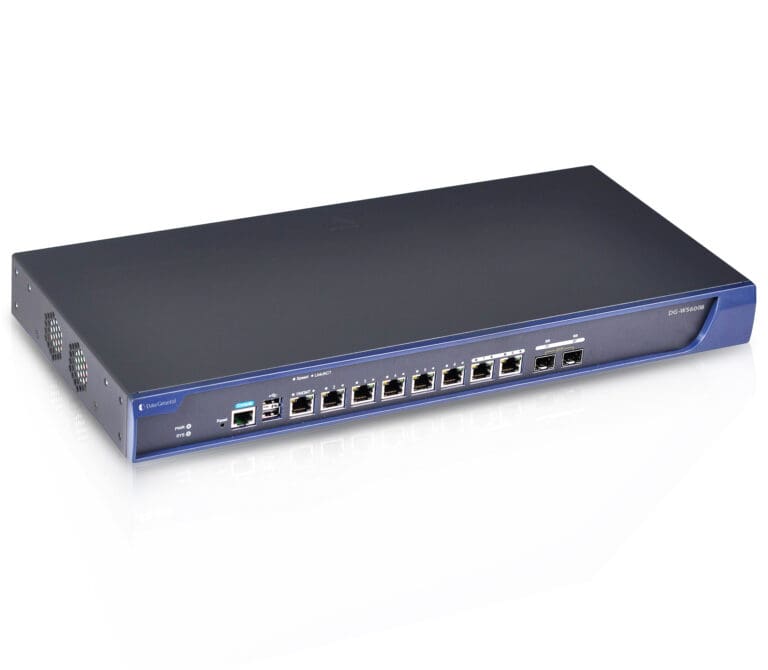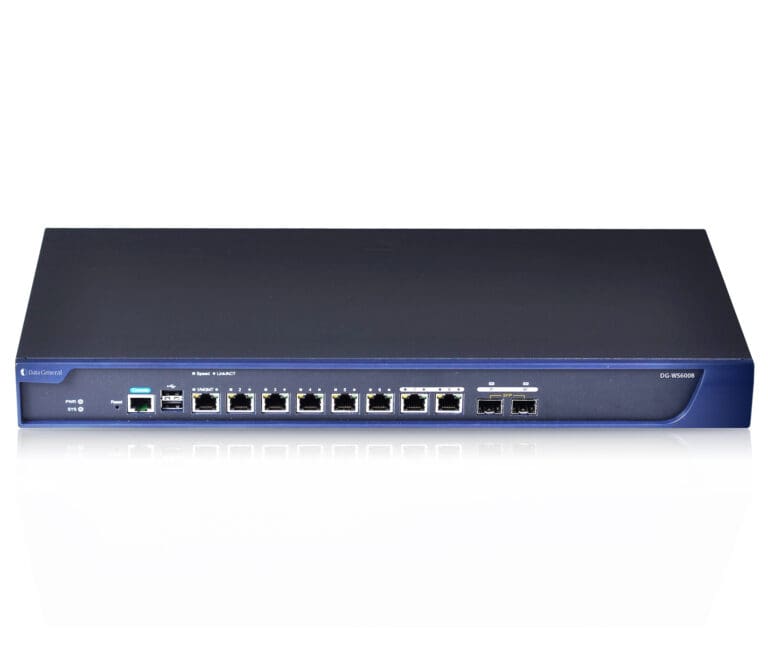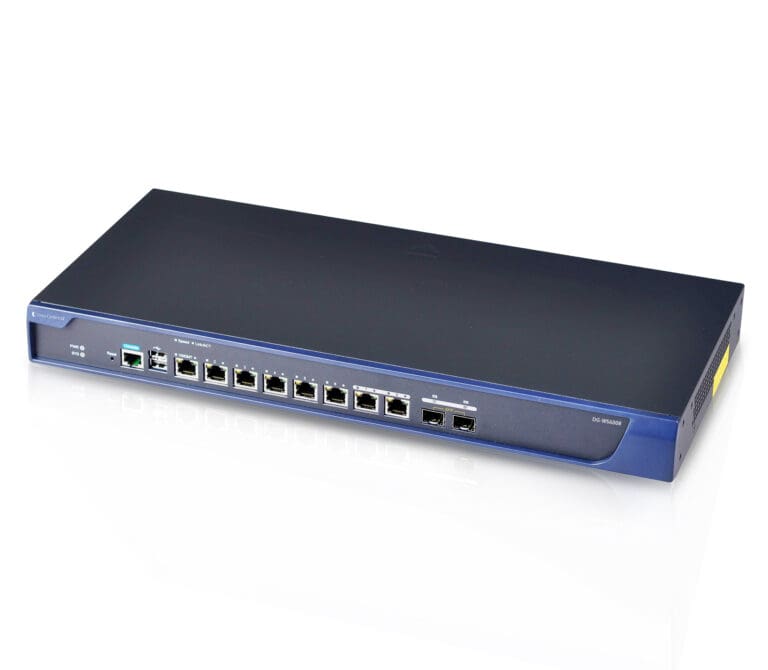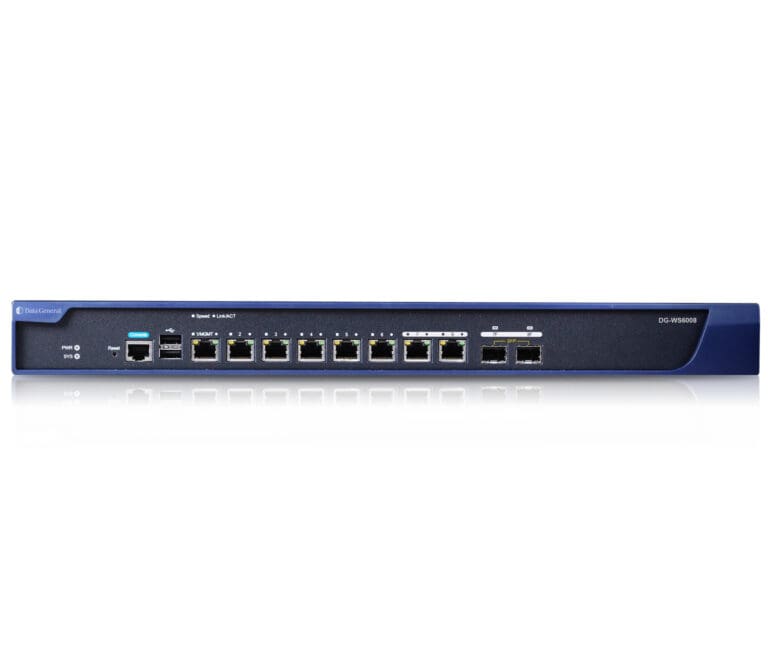WiFi Controller for 224 Access Points
DG-WS6008
- WiFi Controller
- WiFi 6 and WiFi 6E ready
- Up to 224 standard Access Points
- Up to 448 Wall Access Points
- High availability for virtual ACs
- PPSK authentication
- Optimization for High Density
- Seamless roaming
- Load balancing between APs
- Captive guest portal
High Capacity with Permanent License
The Data General WS6008 WiFi Controller is designed to manage up to 224 standard access points or a maximum of 448 in-wall APs, or a combination of both in a 2:1 ratio (in-wall APs to standard APs).
With VAC (Virtual AP Controller) technology, it enhances service availability and allows the deployment of secure networks for guests and visitors through Virtual Access Points. The PPSK (Private Pre-Shared Key) security feature simplifies connection encryption for employees and staff with individual keys, eliminating the need for a shared common key.
In high-density environments, the controller enables optimized load balancing between APs, seamless roaming, and efficient traffic management using CorrectLink technology.
This AP controller is ideal for hotels, schools, small stadiums, or small university campuses, offering high performance and robust network management.




- WiFi Controller
- License required (license for 32 standard APs or 64 wall APs included).
- Licenses are permanent (no renewal required).
- Capacity for 224 normal APs (DG-AP8xx and DG-AP-6xx) or 448 wall APs (DG-AP1xx).
- Up to 7168 users (depending on network environment)
- Roaming handoff < 50 ms
- Up to 4 virtual controllers (VAC)
- Captive portal for 1500 users.
| Modelo | DG-WS6008 | |
|---|---|---|
| Dimensions and Weight | ||
| Dimensions (W x D x H) | 440 mm x 200 mm x 43.6 mm (17.4 in. x 7.9 in. x 1.8 in.) | |
| Rack height | 1 RU | |
| Weight | 2.9 kg (6.4 lbs) | |
| Ports | ||
| Fixed service port | 6 x 10/100/1000Base-T Ethernet ports with auto-negotiation. | |
| ● Auto MDI/MDIX crossover | ||
| ● Port 1 can be used as an out-of-band management port. | ||
| 2 x combo ports, when the combo port is used as an electrical port, it supports | ||
| ● 10/100/1000Base-T auto-negotiation | ||
| ● Auto MDI/MDIX crossover | ||
| Fixed management port | 1 x RJ45 console port | |
| 2 x USB ports | ||
| Status LED | 1 x system status LED | |
| 1 x power status LED | ||
| 10 x service port LEDs | ||
| Button | 1 x Reset button | |
| ● Press the button for shorter than 3 seconds. Then the device restarts. | ||
| ● Press the button for longer than 3 seconds. Then the device restores to factory settings. | ||
| 1 x Power switch button | ||
| Power Supply and Consumption | ||
| Max. power consumption | 40 W | |
| Power module | 1 x 40 W built-in power module | |
| Input voltage | 100 V AC to 240 V AC, 50 Hz to 60 Hz | |
| Input current | 1.5 A (max. RMS current) | |
| Output voltage | 12 V/3.33 A | |
| Power Supply and Consumption | ||
| Max. power consumption | 40 W | |
| Power module | 1 x 40 W built-in power module | |
| Input voltage | 100 V AC to 240 V AC, 50 Hz to 60 Hz | |
| Input current | 1.5 A (max. RMS current) | |
| Output voltage | 12 V/3.33 A | |
| Certifications and Regulatory Compliance | ||
| Safety regulations | GB 4943.1 | |
| CE Marked, EN/IEC 62368-1 (replacing EN/IEC 60950-1) | ||
| Low Voltage Directive 2014/35/EU | ||
| EMC regulations | EN 300 386, EN301 489, | |
| EN 55032 Class A, EN 55035, | ||
| EN 61000-3-2, EN 61000-3-3, | ||
| EN 61000-4-2, EN 61000-4-3, EN 61000-4-4,EN 61000-4-5, | ||
| EN 61000-4-6, EN 61000-4-8, EN 61000-4-11 | ||
| Performance and Capacity | RG-WS6008 | |
| WLAN | ||
| Default number of manageable APs | 32 | |
| Note: The default number of APs that can be managed by the RG-WS6008 is subject to the AP model. See the Ordering Information for details. | ||
| Max. number of configurable APs | 2.048 | |
| Max. number of manageable APs | 448 | |
| Note: The maximum number of APs that can be managed by the RG-WS6008 is subject to the AP model. See the Ordering Information for details. | ||
| Maximum number of manageable STAs | 7.168 | |
| Note: The maximum number of STAs that can be managed by the RG-WS6008 is subject to the network environment. Contact technical support team for details. | ||
| WLAN service | Max. number of WLAN IDs: 2,048 | |
| Max. number of associated STAs per WLAN: 7,168 | ||
| Intra-AC roaming handoff time | < 50 ms | |
| Max. number of virtualized ACs | 4 | |
| Number of concurrent CAPWAP data channels | 2.688 | |
| Routing and Switching | ||
| Number of MAC address entries | 32.768 | |
| Number of VLANs | 4.096 | |
| Number of ARP entries | 32.768 | |
| DHCP address pools | Number of IPv4 address pools: 2,000 | |
| Number of IPv4 addresses: 24,576 | ||
| Number of IPv6 address pools: 256 | ||
| Number of IPv6 addresses: 2,048 | ||
| Number of routing entries | IPv4 routing entries: 8,192 | |
| IPv6 routing entries: 10,000 | ||
| Number of multicast entries | Static routing entries: 2,048 | |
| Multicast group routing entries: 4,096 | ||
| Security and Authentication | ||
| Max. number of STAs supported by the built-in Portal server | 1.5 | |
| Number of ACL entries | 65.536 | |
| Applicable software version | RGOS11.9(6)W1B1 or later | |
| WLAN | RG-WS6008 | |
| IEEE 802.11 protocols | 802.11, 802.11b, 802.11a, 802.11g, 802.11d, 802.11h, 802.11w, 802.11k, 802.11v, 802.11r, 802.11i, 802.11e, 802.11n, 802.11ac, and 802.11ax | |
| CAPWAP | Layer 2 and Layer 3 topology between an AP and an AC | |
| An AP can automatically discover the accessible AC. | ||
| An AP can be automatically upgraded through the AC. | ||
| An AP can automatically download the configuration file from the AC. | ||
| CAPWAP through NAT | ||
| Roaming | Intra-AC Layer 2 or Layer 3 roaming | |
| Inter-AC Layer 2 or Layer 3 roaming | ||
| Forwarding mode | Centralized forwarding | |
| Local forwarding | ||
| Service-based flexible forwarding | ||
| Wireless QoS | AP/WLAN/STA-based rate limiting | |
| (WLAN/STA-based rate limit range: 8-261,120 in the unit of 8 Kbps. For example, if you set the value to 8, the rate limit is 8 x 8 Kbps = 64 Kbps.) | ||
| Static and intelligent rate limiting based on STA quantity | ||
| Fair scheduling | ||
| User isolation | AC-based user isolation | |
| AP-based user isolation | ||
| WLAN-based user isolation | ||
| Reliability | AC virtualization | |
| AC failover | ||
| Multi-AC hot standby (1+1 A/A and A/S hot standby, and N+1 hot standby) | ||
| Multi-AC cluster (N-to-N) | ||
| Remote intelligent perception technology (RIPT) | ||
| Non-stop service during upgrade | ||
| STA management | Access control based on the number of STAs associated with the AP | |
| Access control based on the number of STAs associated with the SSID | ||
| Balanced access control based on the number of STAs associated with the AP | ||
| Balanced access control based on the AP traffic | ||
| Band steering | ||
| Configuration of the RSSI threshold in dB (Range: 0-100) | ||
| Configuration of the STA idle timeout period in seconds (range: 60-86,400) | ||
| WLAN optimization | Adjustment of the transmit power for beacon packets or probe responses | |
| RF management | Country or region code setting | |
| Manual setting of the transmit power | ||
| Automatic setting of the transmit power | ||
| Manual setting of the operating channel | ||
| Automatic setting of the operating channel | ||
| Automatic adjustment of the data rate | ||
| Coverage hole compensation | ||
| AP load balancing based on traffic and STA quantity | ||
| Band selection | ||
| Radio Frequency Interference (RFI) detection and mitigation | ||
| Security | ||
| IPv4 security authentication | Web authentication | |
| 802.1X authentication | ||
| MAB authentication | ||
| SMS authentication | ||
| QR code-based authentication | ||
| IPv6 security authentication | Web authentication | |
| IEEE 802.11 security and encryption | Multi-SSID mode | |
| SSID hiding | ||
| IEEE 802.11i-compliant PSK authentication | ||
| WPA and WPA2 | ||
| WPA3: WPA3-Personal (SAE), WPA3-Enterprise (CCMP, 128-bit), and WPA3-Enterprise (GCMP, 192-bit) | ||
| WEP (WEP/WEP128) | ||
| TKIP | ||
| CCMP | ||
| Anti-ARP spoofing | ||
| CPP | Supported | |
| NFPP | Supported | |
| WIDS | Supported | |
| AP virtualization | Supported | |
| Protocols | ||
| IPv4 protocols | Ping and traceroute | |
| DHCP server, DHCP client, DHCP relay, and DHCP snooping | ||
| DNS client | ||
| NTP | ||
| Telnet | ||
| TFTP server and TFTP client | ||
| FTP server and FTP client | ||
| IPv6 protocols | DNSv6 client | |
| DHCPv6 relay and DHCPv6 server | ||
| TFTPv6 client | ||
| FTPv6 server and FTPv6 client | ||
| IPv6 CAPWAP | ||
| ICMPv6 | ||
| IPv6 ping | ||
| Manual tunnels and automatic tunnels | ||
| Manually configured IP addresses and automatically created local addresses | ||
| IPv6 traceroute | ||
| IPv4 routing | Static routing, RIP, and OSPF | |
| IPv6 routing | Static routing | |
| Management | ||
| Network management | SNMP v1/v2c/v3 | |
| RMON | ||
| Syslog | ||
| Network management platform | Eweb | |
| Ruijie Cloud | ||
| RIIL | ||
| Wi-Fi heat map | ||
| User access management | Console port login,Telnet login,SSH login,and FTP upload | |
[integrate_dropbox id=”18″]
